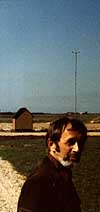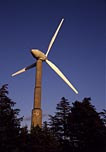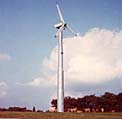Wind
Turbines From the 1980s

The
Riisager Turbine

![]() A carpenter, Christian Riisager,
however, built a small 22
kW wind turbine (39K, JPEG) in his own back yard using the
Gedser Wind Turbine design as a point of departure. He used inexpensive
standard components (e.g. an electric motor as generator, and
car parts for gear and mechanical brake) wherever possible.
A carpenter, Christian Riisager,
however, built a small 22
kW wind turbine (39K, JPEG) in his own back yard using the
Gedser Wind Turbine design as a point of departure. He used inexpensive
standard components (e.g. an electric motor as generator, and
car parts for gear and mechanical brake) wherever possible.
![]() Riisager's
turbine became a success with many private households around
Denmark, and his success gave the present day Danish wind turbine
manufacturers their inspiration to start designing their own
wind turbines from around 1980.
Riisager's
turbine became a success with many private households around
Denmark, and his success gave the present day Danish wind turbine
manufacturers their inspiration to start designing their own
wind turbines from around 1980.
![]() (Photograph
© 1996 Copyright The Electricity Museum, Bjerringbro, Denmark).
(Photograph
© 1996 Copyright The Electricity Museum, Bjerringbro, Denmark).
Competing Turbine Designs

![]() Picture
from the secret testing grounds of Vestas Wind Systems in 1979:
The engineer Léon Bjervig next to his 12 kW 7.3 m rotor
diameter Darrieus "biplane" machine.
Picture
from the secret testing grounds of Vestas Wind Systems in 1979:
The engineer Léon Bjervig next to his 12 kW 7.3 m rotor
diameter Darrieus "biplane" machine.
Picture © BTM Consult 1979.

The
Tvind 2 MW Machine

![]() One important exception
to the rule of small machines was the Tvind 2 MW machine,
a fairly revolutionary machine, (in a political sense, too, having
been built by idealist volunteers, practising gender quotas and
other politically correct activities, including waving Chairman
Mao's little red book.) The machine is a downwind
machine with 54 m rotor diameter running at variable speed with
a synchronous generator,
and indirect grid connection
using power electronics. The machine is still running nicely.
(Photograph © 1998 Soren Krohn)
One important exception
to the rule of small machines was the Tvind 2 MW machine,
a fairly revolutionary machine, (in a political sense, too, having
been built by idealist volunteers, practising gender quotas and
other politically correct activities, including waving Chairman
Mao's little red book.) The machine is a downwind
machine with 54 m rotor diameter running at variable speed with
a synchronous generator,
and indirect grid connection
using power electronics. The machine is still running nicely.
(Photograph © 1998 Soren Krohn)
![]() Early Danish wind turbine development was
thus a far cry from simultaneous government sponsored research
programmes on very large machines in Germany, USA, Sweden, the
UK, or Canada.
Early Danish wind turbine development was
thus a far cry from simultaneous government sponsored research
programmes on very large machines in Germany, USA, Sweden, the
UK, or Canada.
![]() In
the end, improved versions of the classical, three-bladed upwind
design from the Gedser wind turbine appeared as the commercial
winner of this wild competition, but admittedly not without a
number of wreckages, mechanical, and financial.
In
the end, improved versions of the classical, three-bladed upwind
design from the Gedser wind turbine appeared as the commercial
winner of this wild competition, but admittedly not without a
number of wreckages, mechanical, and financial.
Risoe
National Laboratory
Risoe National Laboratory was really born to become
the Danish answer to Los Alamos, i.e. the national centre for
nuclear research. Today it is far better known for its work on
wind energy.
![]() Risoe
National Laboratory's Department of Wind Energy and Atmospheric
Physics has a staff of some 100 people working on basic research
into aeroelastics, i.e. the interaction between aerodynamics
and structural dynamics, on wind turbine technology, and
wind resource assessment. It also has a separate, small, commercial
activity dealing with type approval of wind turbines.
Risoe
National Laboratory's Department of Wind Energy and Atmospheric
Physics has a staff of some 100 people working on basic research
into aeroelastics, i.e. the interaction between aerodynamics
and structural dynamics, on wind turbine technology, and
wind resource assessment. It also has a separate, small, commercial
activity dealing with type approval of wind turbines.
![]() Risoe
was originally founded with this last purpose in mind, when the
Danish Government instituted a support programme for the erection
of wind turbines in Denmark. In order to protect the buyers of
wind turbines (and their surroundings) the Government required
that all supported wind turbines be type approved for safety.
The strict safety regulations (including requirements for dual
braking systems) indirectly helped developing safer and more
reliable wind turbines. (The support programme was abandoned
in 1989).
Risoe
was originally founded with this last purpose in mind, when the
Danish Government instituted a support programme for the erection
of wind turbines in Denmark. In order to protect the buyers of
wind turbines (and their surroundings) the Government required
that all supported wind turbines be type approved for safety.
The strict safety regulations (including requirements for dual
braking systems) indirectly helped developing safer and more
reliable wind turbines. (The support programme was abandoned
in 1989).
Bonus
30 kW

![]() The Bonus 30 kW machine (21K, JPEG) manufactured
from 1980 is an example of one of the early models from present
day manufacturers.
The Bonus 30 kW machine (21K, JPEG) manufactured
from 1980 is an example of one of the early models from present
day manufacturers.
![]() Like
most other Danish manufacturers, the company was originally a
manufacturer of agricultural machinery.
Like
most other Danish manufacturers, the company was originally a
manufacturer of agricultural machinery.
![]() The
basic design in these machines was developed much further in
subsequent generations of wind turbines.
The
basic design in these machines was developed much further in
subsequent generations of wind turbines.
![]() (Photograph
copyright Bonus Energy A/S).
(Photograph
copyright Bonus Energy A/S).
© Copyright 1998 Søren Krohn.
Updated 15 December 2000
http://www.windpower.org/pictures/eighties.htm